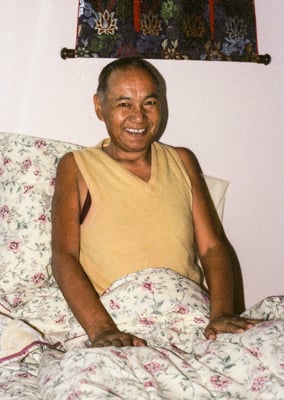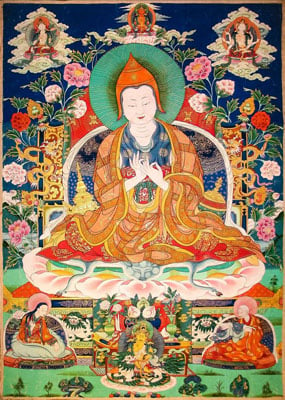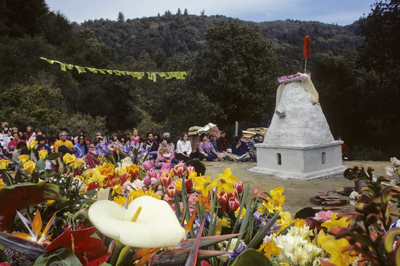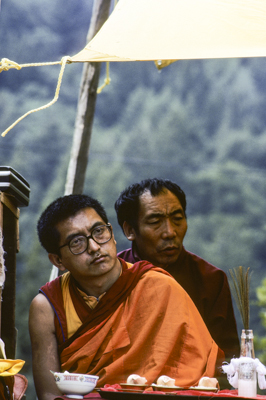Dear LYWA friends and supporters,
Thank you so much for your interest in the Lama Yeshe Wisdom Archive. And please let us know if we can help you in any way.
The Anniversary of Lama Yeshe's Passing This year, Losar, the Tibetan New Year, falls on Sunday, March 2nd. Thirty years ago, in 1984, it fell on March 3rd. At dawn that day, our precious guru Lama Thubten Yeshe passed away. Auspicious timing but a terrible loss to Lama’s students and, indeed, the world, for he was one of the three or four most influential teachers in the spread of Tibetan Buddhism throughout the world. But even though we lost Lama’s physical presence at that time, now, thirty years on, we are able to enjoy his legacy multiplied fourfold through the foundation he established, the Foundation for the Preservation of the Mahayana Tradition (FPMT), the largest Tibetan Buddhist organization in the world.
This year, Losar, the Tibetan New Year, falls on Sunday, March 2nd. Thirty years ago, in 1984, it fell on March 3rd. At dawn that day, our precious guru Lama Thubten Yeshe passed away. Auspicious timing but a terrible loss to Lama’s students and, indeed, the world, for he was one of the three or four most influential teachers in the spread of Tibetan Buddhism throughout the world. But even though we lost Lama’s physical presence at that time, now, thirty years on, we are able to enjoy his legacy multiplied fourfold through the foundation he established, the Foundation for the Preservation of the Mahayana Tradition (FPMT), the largest Tibetan Buddhist organization in the world.
After Lama left us, his chief disciple, Lama Zopa Rinpoche, took the reins of the FPMT and it is because of his peerless guidance and incomparable example that the Foundation has become the highly beneficial entity that it has, as evidenced by its latest annual review.
In 1984, we published a special issue of Wisdom magazine (forerunner of Mandala) to commemorate and celebrate Lama’s life. You can also read some of the tributes here. Rinpoche's address at the funeral is excerpted below as this month's eletter teaching.
Five years ago, Mandala also published a remembrance of Lama on the twenty-fifth anniversary of his passing.
And, of course, the Lama Yeshe Wisdom Archive stands as a permanent tribute to both Lama Yeshe and Lama Zopa Rinpoche, bringing you the essence of their being, their pure Dharma teachings, given for the benefit of all sentient beings. Moreover, this year will see the finishing touches put on our biggest project by far, more than twenty-five years in the making, Big Love: The Life and Teachings of Lama Yeshe.
Thank you for your support of all this!
Losar, Monlam and the Day of Miracles
March is a very auspicious time for merit accumulation, beginning on March 2nd with Losar, the Tibetan New Year. On Losar Tibetan families gather together to clean, rejoice and make extensive and special offerings for peace and prosperity in the new year. Losar is also an extremely special day for the FPMT family as it marks the passing of our supremely kind founder Lama Yeshe. Losar is followed by the Monlam Chenmo or the Great Prayer Festival which extends beyond Losar for 15 days. The great Lama Tsongkhapa instituted the Monlam Tradition in 1409 to gather together monks, nuns and laypeople from all over Tibet into the Jokhang at Lhasa for extensive prayers, pujas, teachings and other meritorious activities. In 1995 Mandala Magazine printed Lama Yeshe's tribute to Lama Tsongkhapa.
Losar is followed by the Monlam Chenmo or the Great Prayer Festival which extends beyond Losar for 15 days. The great Lama Tsongkhapa instituted the Monlam Tradition in 1409 to gather together monks, nuns and laypeople from all over Tibet into the Jokhang at Lhasa for extensive prayers, pujas, teachings and other meritorious activities. In 1995 Mandala Magazine printed Lama Yeshe's tribute to Lama Tsongkhapa.
Lama Tsongkhapa chose the Monlam Chenmo to coincide with the anniversary of incredible events in Shakyamuni Buddha's life traditionally celebrated during the first two weeks of the lunar new year. As cited by Lama Zopa Rinpoche from the Vinaya text Treasure of Quotations and Logic, the karmic power of all actions done on the anniversary of these events is multiplied by one hundred million!
Shakyamuni Buddha had been challenged by six rival teachers for many years to prove his miraculous powers. The Buddha finally accepted the challenge and began on the lunar new year. The Buddha then displayed miracle after miracle for the next 15 days, finishing on the Day of Miracles. Due to the power of these miraculous displays the Buddha turned the minds of the six rival teachers and the huge crowds who were watching to the Dharma.
We invite you to join with us during this very auspicious time in practicing virtue and increasing our commitments to our teachers and the Dharma. See the FPMT website for a link to Rinpoche's advice on How to Make the 15 Days of Miracles Meaningful and practices specifically recommended by Rinpoche for Buddha Multiplying Days.
We also invite you to avail yourself of the opportunity to make an offering to the Archive during this time and rejoice in all the extra merit accumulated!
Lama Yeshe Teachings and Video
As I mentioned above, the Archive continues to celebrate the life of Lama Yeshe by making his teachings and life story available to all in many ways. Lama's teachings are regularly featured online in the Elephant Journal, and every week we add a new post to the Big Love blog, featuring excerpts from the upcoming biography.
And as we announced in our January eletter, we recently posted samples of our new enhanced ebooks on iTunes. Just search iTunes from your device for "Making the Most of Your Life" by Lama Yeshe or "The Merely Imputed I" by Lama Zopa Rinpoche to find and download these free samples. We are excited about this new technology and look forward to making more teachings available in this and similar formats.
Also, visit our YouTube channel where you can see the latest installment in the eight-part series that we have been posting of Lama Yeshe's Thousand-Arm Chenrezig Commentary, organized by Vajrapani Institute at Grizzly Lodge, California in May 1980.
New Teachings and Advice From Lama Zopa Rinpoche
We have just posted two excerpts from Rinpoche's teachings in Singapore in 2013. The first is a teaching on the benefits of making offerings to holy objects and how to create skies of merit by reciting the Offering Cloud Mantra. The second is a talk given to volunteers at Amitabha Buddhist Centre on why we need the Dharma center, where Rinpoche says:
Here you can understand how important is the teacher, who educates sentient beings and shows the path to all these different levels of happiness up to enlightenment, so that is the most, most, most, most unbelievably important. It’s like opening the eye. We have two eyes, but it is really opening deep, most deep like an ocean, most deep, extensive to understand, opening the Dharma eye—the Dharma teacher opens the Dharma eye, can you imagine! So you can see how so important that is. Wow, wow wow, wow.
In Rinpoche's Advice book, read a recent letter that Rinpoche wrote to an old friend. Rinpoche had a pen pal when he was staying at a Tibetan refugee camp in Buxa Duar, India in the early 1970s. Rinpoche received a letter from him after forty years and sent a long response about his life, the history of FPMT and essential practices.
Other new advices this month include a letter Rinpoche dictated about the three types of suffering to a student’s mother, who was worried about death; a letter of gratitude to a student who organized numerous animal liberations; advice on overcoming depression; and many more.
Updates to Our Online Image Gallery Many of the images you see above are from the collection of photos taken during Lama's cremation ceremony. You can view the entire collection here.
Many of the images you see above are from the collection of photos taken during Lama's cremation ceremony. You can view the entire collection here.
We have also recently added two new albums of photos of Lama Zopa Rinpoche, one which is a series of portraits taken in Taos, NM in 1999, and the other which includes various photos from 2010.
We wish you all the best in this new year, and look forward to all we will be accomplishing together in the months to come.
Much love,
Nick Ribush
Director
This Month's Teaching: Rinpoche's Talk at Lama Yeshe’s Funeral
 I am just very numb, I can’t think of anything. But I thought I would try and say a few words regarding the recent happenings.
I am just very numb, I can’t think of anything. But I thought I would try and say a few words regarding the recent happenings.
This year, not only our incomparably kind guru, Lama Yeshe, but also His Holiness Ling Rinpoche and his Holiness Tsenshap Serkong Rinpoche have passed away. And other lamas not common to us, other high lamas have passed away as well, this year in India. Whatever other people say, I don’t know, but my own way of thinking is that because of our karmic vision there were great obstacles in His Holiness the Dalai Lama’s forty ninth year. So, it became kind of a choice, according to our karma; either His Holiness passes away or other lamas pass away.
The main thing is: we sentient beings who receive guidance from these high lamas, these holy beings, we simply don’t have enough merit. You see, the vase, the vessel, is too small. Even if there is one very large pot of nectar, all of it cannot fit into that small vessel. I think that is the main problem. These high lamas, His Holiness and all these high lamas, including Lama Yeshe, they do not fit us, they do not fit. Because of our small merit, they just do not fit. They are like a huge burden that we cannot carry.
We need to have incredible merit for all these holy beings guiding us to have a long life. But there is a shortage of merit—even if there is no Dharma contact and we do not have guru-disciple relationship. And to those with whom we have had Dharma contact we have done many things to cause a shortage of their lives, for them to not stay in that aspect to guide us. We have caused it.
As it is with high lamas, so it is the same regarding Lama’s passing away. And it is not something that suddenly happened. Lama planned it some time ago; there have been many preparations. Last year when Lama was in France, for example, he told—Denis Huet, the director of Vajra Yogini Institute—he is very close to Lama, in Lama’s heart—he told Denis: ‘I will leave my body at New Year.’ I said to Denis, ‘But Lama must be joking!’ He said, ‘No, Lama is serious.’ I told Denis that he should write to Lama and explain to him all the reasons why he should live long.
So, it’s not as if Lama was an ordinary person without any choice in death, not like that.
And recently, just before Lama left Dharamsala, almost every day, over and over, he would be saying things like, ‘If I don’t die then I will do this; if I don’t die...’ Always death, always conversations involving death, all the time.
That morning, just before completing the past year, also Lama’s forty-ninth year, Lama asked me to do the Heruka sadhana with self-initiation with him. Even though Lama was in the aspect of heavy sickness he was able to keep straight and do the Heruka self-initiation. I know that if I had had such problems I would not even remember om mani padme hum. Even when I am healthy I cannot remember it; when I am sick—impossible! I would only have thoughts of my sickness, nothing else.
Anyway, soon after we had finished the sadhana I had some kind of hesitation in my mind, a feeling that something heavy might happen. But I couldn’t decide on the basis of Lama’s holy body whether he was going to pass away. So I said to Lama, ‘Please, you should consider recovering soon because the students understand the Dharma. They’re very intelligent and they can change their minds and they can become more harmonious.’ When I said ‘they can change their minds and they can become more harmonious’ Lama didn’t speak but he put up his hand strongly. Somehow he just didn’t accept. This was quite close to the time of his passing away.
So I think we can understand from Lama’s signal, quite tough, that he could not accept. We can see from that, it is clear.
Recently, I heard that if you make a mistake with one guru, that pollution will cause you to make mistakes with other gurus, even though in the first place the mistake was only with one.
However, the main point is that Lama did not accept, he did not respond. But since our mind is not oneness with anger, not oneness with ignorance, not oneness with attachment, as everybody knows: since they are not mixed with our mind, since it is possible to separate them from our mind, then I think we should attempt to subdue the mind and develop a good heart. And in that way harmony will come. This, then, becomes pleasing to Lama—even though no longer the same aspect—and becomes the best offering and a cause for him to reincarnate quickly and guide us. Again we will be able to enjoy the continuous nectar of the profound and extensive teachings of Lama.
I think the most pleasing thing at each center, the first thing, the most important thing is to be able to develop one’s own mind, to practice bodhicitta and patience as much as possible, to develop a good heart. Then, you see, that center will really develop. It will have an incredibly good vibration, harmonious and with no confusion, and just by being there people will be able to generate realizations easily. People will want to stay there, they will want to do retreat, they will want to do things. This is the best way to develop a center.
Just to talk generally about the development of the center, about teachings, without relating it all to one’s own mind, makes the Dharma something in the sky. You can’t point out the teachings somewhere in the sky. We must relate them to our own mind, our own life. That is the best offering to the Lama, that is fulfilling Lama’s wishes.
You can read the remainder of Rinpoche's address, as well as an account of Lama's last days and many other tributes, on our website, or read the special issue of Wisdom magazine online































